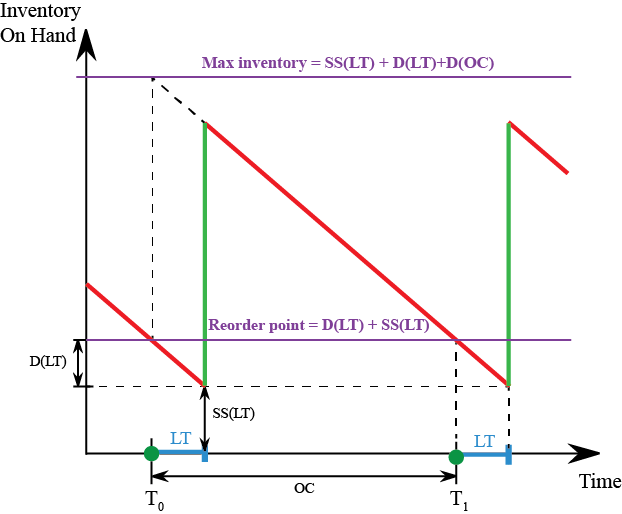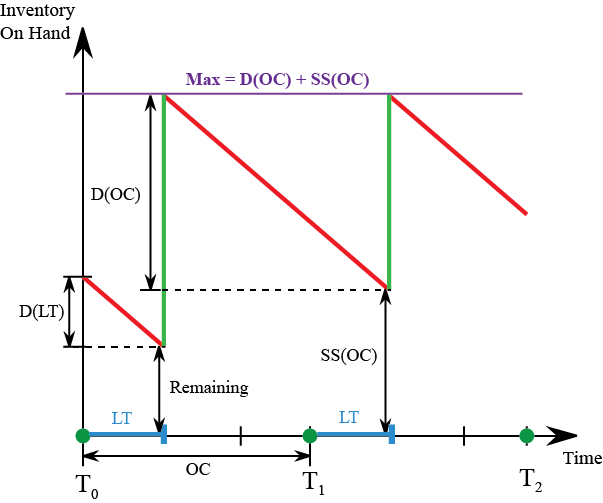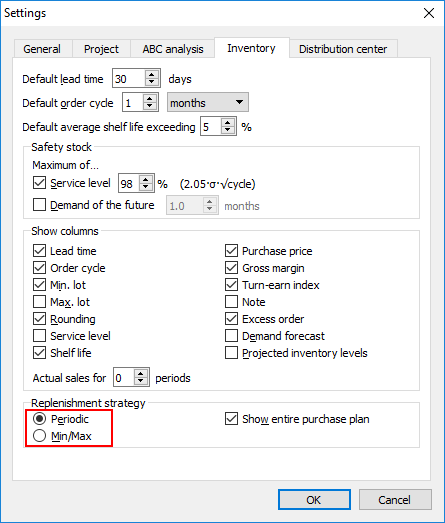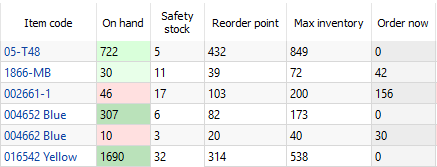User Guide
1. Streamline Client
2.Streamline Server
3. Starting Up
4. Connecting data
5. Demand and Sales Forecasting
6. Inventory Planning
7. Reference
1. Streamline Client
2.Streamline Server
3. Starting Up
4. Connecting data
5. Demand and Sales Forecasting
6. Inventory Planning
7. Reference
 Add this page to your book
Add this page to your book  Remove this page from your book
Remove this page from your book In this article we:
There are two fundamentally different replenishment strategies depending on the overall objective: 1) placing orders at any time or 2) at specific time points:
The goal of a replenishment strategy is to determine:
These factors are based on the given service level and other data. In the case of the Min/max strategy, the outcomes of the strategy also include the reorder point and max inventory level.
Both strategies use a lot-sizing method to determine the optimal lot size. The method selected should be the most efficient for a given demand pattern. The effectiveness is determined by the trade-off between the SKU (item) carrying costs and the costs of ordering it from the supplier. In the case of the Periodic strategy, this compromise also indicates the future periods in which replenishment orders should be issued, i.e. determines the order cycle – the time between two successive replenishment orders. Order cycle can be constant or variable depending on the lot-sizing method. Here is a list of commonly used lot-sizing methods:
A trade-off between carrying costs and ordering costs can result in a different relationship between order cycle and supplier lead time (longer lead time). Let’s denote these characteristics as OC and LT. The variants of the relationship and their characteristics are given in the table below.
| Relationship | Characteristics |
|---|---|
| OC > LT |
|
| OC < LT |
|
If the case when OC > LT can be planned relatively easy, then the situation when order cycle is less than lead time is significantly difficult to plan. In this case, we need to organize a sequence of replenishment orders and calculate their arrival dates precisely in order to cover demand during LT.
Application of the Min/max strategy is usually characterized by:
This strategy is typically applied in retail trade.
The Periodic strategy is usually characterized by:
This strategy is typically applied by distributors, wholesale centers, and manufacturers.
To provide optimal inventory levels and maintain favorable service levels, both strategies rely on several assumptions and limitations:
Streamline allows implementation of both the Min/max and Periodic replenishment strategies. The lot-sizing method used to calculate the optimal lot size is the Periods of supply method. In this approach, the lot size is calculated based on the demand of a given number of future periods. Therefore, it requires the Order cycle to be set by the user.
Streamline can build replenishment plans when OC ≥ LT and vice versa. If lead time is greater than order cycle, Streamline creates a sequence of replenishment orders.
In addition, Streamline supports two-echelon planning. This situation is typical when there is a central warehouse or distribution center that supplies a set of stores in different locations. In this case, the warehouse is usually supplied using the Periodic strategy, and the stores – using the Min/max strategy. Streamline allows you to set up the strategy at each echelon.
To describe Streamline’s replenishment process, let’s introduce the following notation:
In this section, we describe how Streamline drives the replenishment process using the Min/max strategy. The figure below shows the replenishment process.

T0, T1, … - time points when replenishment orders are placed.
As you see, Streamline:
Reorder point = D(LT)+SS(LT); andSS(LT)+D(LT)+D(OC).Streamline requires you to set up or import the Order cycle parameter in order to calculate the Max inventory level.
In this section, we describe how Streamline drives the replenishment process using the Periodic strategy. The figure below shows the replenishment process.

T0, T1, … - stock levels review time points. Only at these time points can replenishment orders be placed.
As you see, Streamline:
D(OC)+SS(OC); andD(OC)+SS(OC).To set up a strategy for all your locations except the distribution center:

Replenishment strategy for the distribution center is set up on the Distribution center tab of the Settings dialog. It is done in the same way as described above (see figure below). The distribution center should be enabled, of course.

The main outcomes of the replenishment strategies are the safety stock level and a replenishment plan. In the case of the Min/max strategy, the outcomes also include the reorder point and max inventory level.
Replenishment recommendations and key results of the selected strategy are shown on the Inventory planning tab. Depending on the strategy the Inventory planning shows different columns which make up the Streamline's Replenishment plan.
In the case of the Periodic strategy, the table shows the Safety stock column and Order now section (see figure below) consisting of three sub-sections:
Safety stock is an assessment of the reserve stock for the next order cycle period.
The Purchase plan section (see figure below) indicates how much you should order by the 1st day of each period. For example, you should order 450 units of item 05-T48 by the 1st of February 2017. This section is visible when the Show entire purchase plan option is checked.

If the Min/Max strategy is selected in the Settings, the Inventory planning table shows key information in the following columns (see figure below):

To learn more about the settings and parameters affecting the replenishment process and how you can configure them, refer to the Configuring replenishment parameters page.